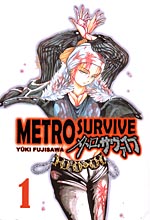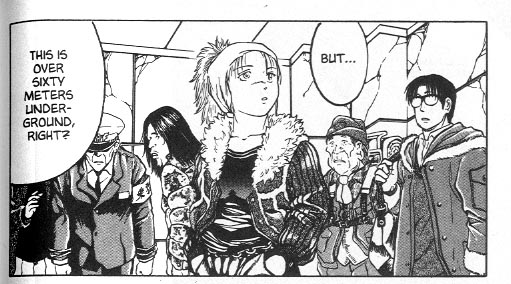 By Yuki Fujisawa
By Yuki Fujisawa
208 pages, black and white
Published by DrMaster Publications
In the 21st century, one particular sub-genre I’ve noticed gaining a lot of prominence these days is the “post-disaster” story. It’s not so much about the incident itself, but rather people caught up in its wake that have to fight to survive. That’s not to say that this sort of thing is a recent idea, of course, but I don’t think it’s any small coincidence that in the past decade there’s an increased frequency in which these sort of stories show up in popular media. The latest one I’ve found crossing my path is Yuki Fujisawa’s Metro Survive, a two-volume story about a group of hapless individuals trapped by a horrible disaster. The problem is, I’m not entirely sure Fujisawa can decide just what the true disaster of this story really is.
Mishima works at the Exopolis Tower in Tokyo, a brand new high rise office building complete with its own subway station and numerous stores built into the lower levels. Forever pushed around and abused by his bosses, Mishima is forced to stay late to fix yet another problem in the shoddily-constructed Exopolis Tower and misses his son’s birthday. Unfortunately, that’s just the start of things going wrong, as a massive earthquake hits and traps Mishima’s subway train underneath the collapsing tower. Can he and the other passengers survive? And even if they can get out of the tunnels, what further nightmares await them?
Fujisawa seems to have grand ideas for Metro Survive, trying to make it so much more than just a typical “natural disaster hits innocent people” story. And on some levels, I think that really works. The idea that the Exopolis Tower was a rushed project that was built with substandard equipment is a strong enough base to build a story around, and having the wimpy Mishima slowly rise up to become a leader of his small group of survivors works well in this context. Up until about the two-thirds mark, I enjoyed the way that Fujisawa continues to up the ante for the characters of Metro Survive. Just because they can get out of the car doesn’t mean they’re in the clear, after all, and each new obstacle has its own nasty surprise in store for them. (Fujisawa isn’t beyond the slightly gruesome, either. The revelation of what happened to the subway passengers that abandoned everyone in Mishima’s jammed car was rather surprising, for starters, and made me more impressed that Fujisawa wasn’t afraid to have really bad things happen to people in this story.) The problem only really hits once Fujisawa’s group finds additional people, and Metro Survive turns into a second-rate Lord of the Flies. As a reader I could buy the whole shifting of the villain of the piece going from the earthquake to the greedy creators of Exopolis who skimped on safety. With this latest change, though, it seems to becoming a “We are all the villains” piece, and it’s hard to buy into that. First, doing so means you have to reject all the good things that Mishima and several of the other characters of Metro Survive did up until this point. And second, expanding the cast just doesn’t quite work in terms of a storytelling structure. Their sudden appearance (and then descent into villainy) not only is jarring, but it smacks of Fujisawa suddenly realizing he doesn’t have enough characters left and needs to invent more villains for the piece. It’s a little clumsy, and hopefully the concluding volume of Metro Survive will quickly move away from this misguided journey into evil preening night club hosts.

The art in Metro Survive is ultimately average. I like the way that Fujisawa draws Mishima as a slightly schlumpy, ordinary looking guy that you wouldn’t give a second glance if seen on the street. He and the rest of the “ordinary” people of Metro Survive are where Fujisawa’s strengths are when it comes to characters. Unfortunately, any character who doesn’t fall into that category seems a little too exaggerated, a little too out there. The ever-complaining tough guys seem straight out of a bad 1980s music video involving gangs, and the less said about the greasy and slicked-back night club hosts, the better. Fortunately, the best thing about the art for Metro Survive is how Fujisawa shows the damage. When the characters gaze up through the wreckage, or discover the collapsed ceilings over the escalators, it really brings home the idea of just how dire their situation is—it really sells Fujisawa’s story in a way that it otherwise might not have succeeded.
Metro Survive Vol. 1 is a good, but not great book. Knowing that it’s just two volumes long actually helps a great deal for me, because if this threatened to stretch on for twenty volumes I probably wouldn’t be as interested in seeing what happens next. But with an end point in sight, it gives me hope that the “two groups of rival survivors” aspect will hopefully go away quickly, and Fujisawa can shift the focus back onto the simpler ideas of innocent people being caught up in a larger company’s folly. It’s a nice diversion to dip into, and here’s hoping the second book will play more to Fujisawa’s strengths. I’ll certainly check it out to discover the answer.
Purchase Links: Amazon.com
